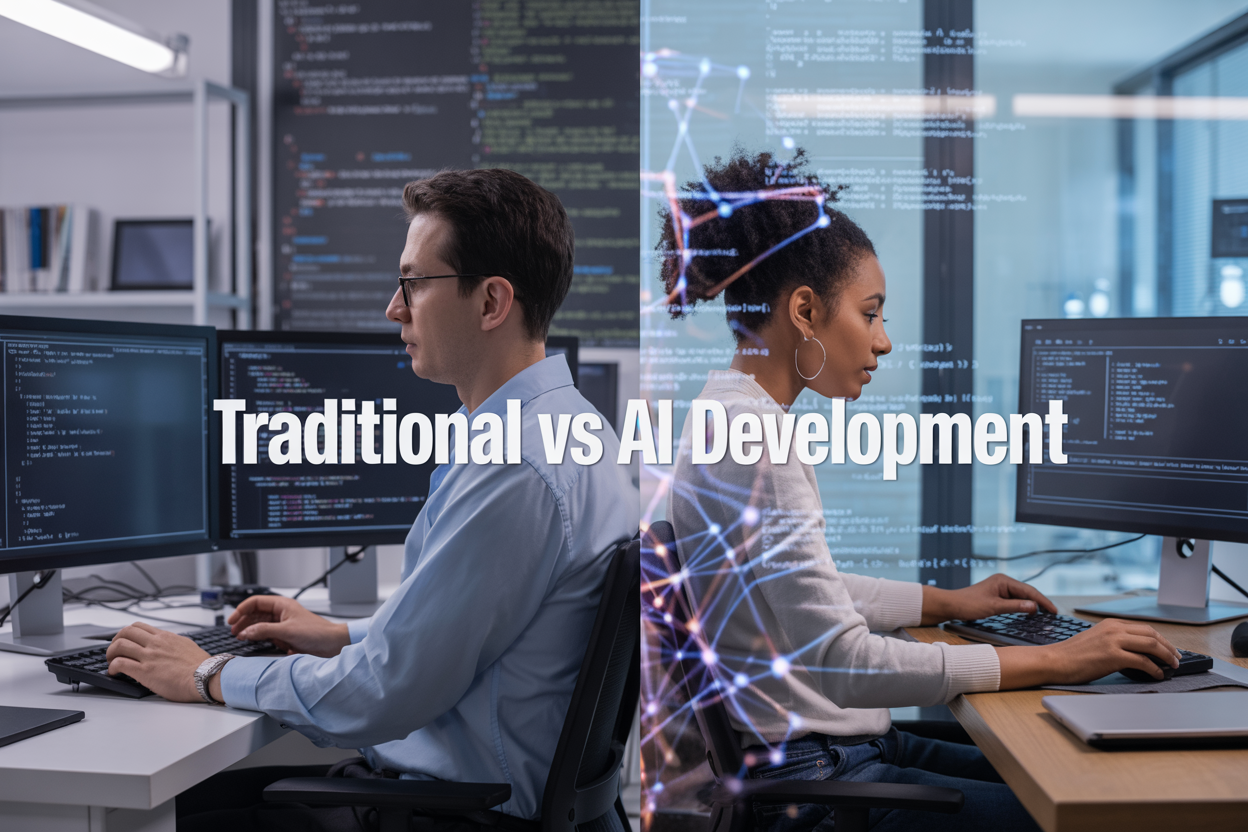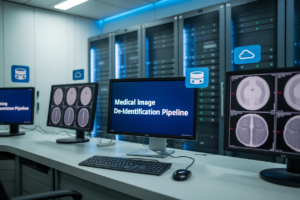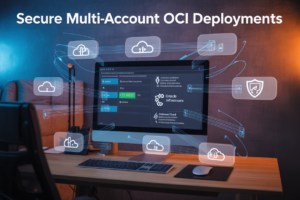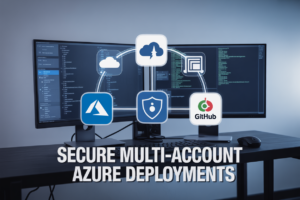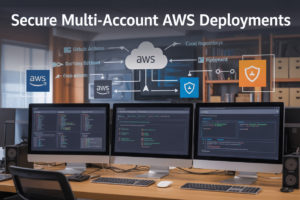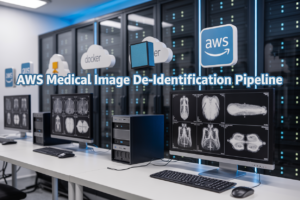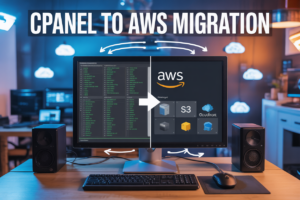Do We Still Need Traditional Software for Development in the Age of AI?
AI coding assistants and AI development tools are reshaping how developers work, but the question remains: can AI completely replace traditional software development methods? This guide is for development teams, tech leads, and software engineers trying to figure out the best approach for their projects in 2024.
The short answer? Traditional programming tools and AI-powered development both have their place in modern workflows. While AI excels at automating repetitive tasks and speeding up code generation, traditional software development tools remain essential for complex problem-solving, debugging, and maintaining code quality.
We’ll explore which traditional development tools are still irreplaceable, examine where AI vs traditional development methods each shine brightest, and show you how to build a hybrid development approach that combines the best of both worlds. You’ll also discover practical strategies for integrating AI software development benefits into your existing workflows without losing the reliability of proven traditional methods.
Understanding AI’s Current Impact on Development Workflows
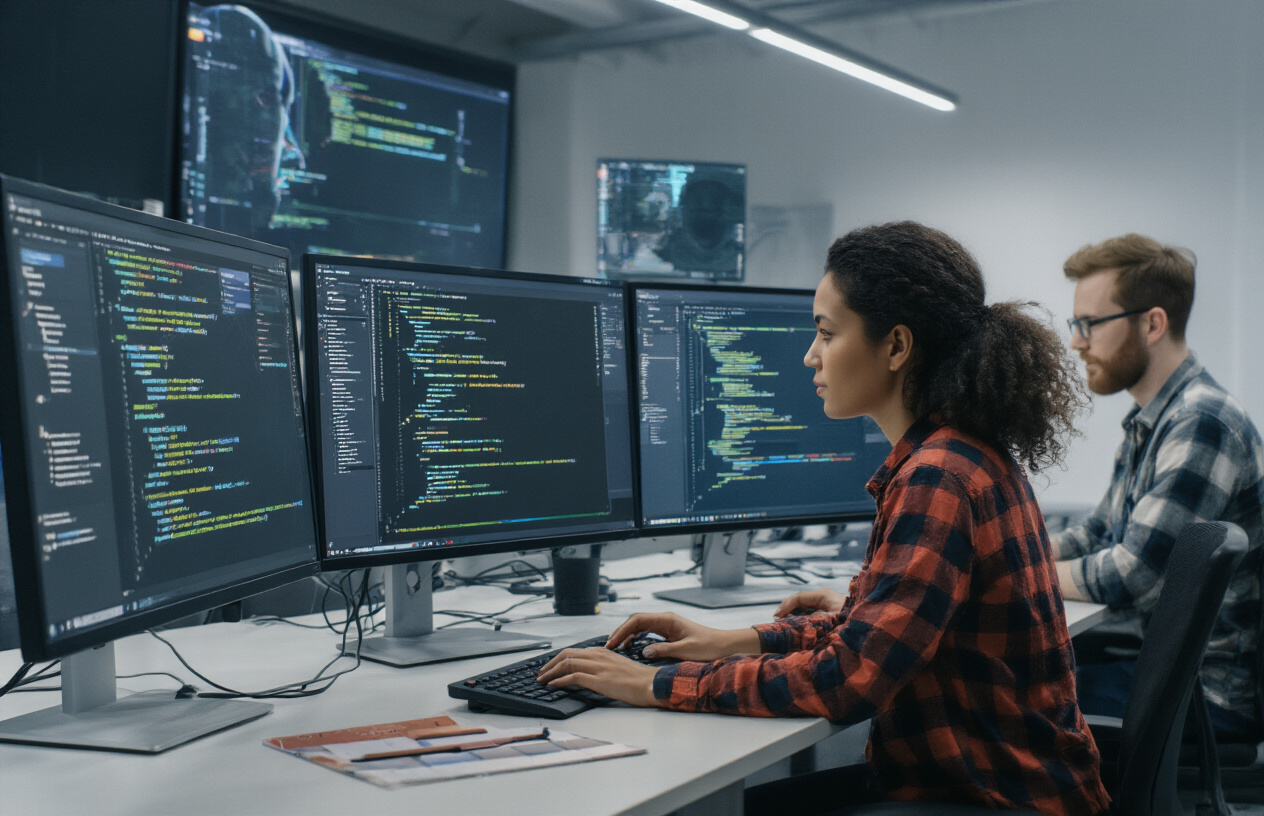
How AI coding assistants are transforming daily programming tasks
GitHub Copilot, ChatGPT, and similar AI development tools have fundamentally changed how developers write code. These AI coding assistants now handle routine tasks like generating boilerplate code, writing unit tests, and debugging syntax errors in real-time. Developers report spending 40% less time on repetitive coding tasks, allowing them to focus on complex problem-solving and system architecture instead.
Real-world productivity gains from AI-powered development tools
Companies using AI development tools see measurable improvements in their development workflows. Netflix reduced code review time by 35% using AI-assisted code analysis, while Shopify’s developers complete features 25% faster with AI pair programming. Junior developers particularly benefit, with studies showing 60% improvement in code quality when using AI coding assistants for guidance and suggestions.
Limitations AI still faces in complex software architecture
AI struggles with large-scale system design and architectural decisions that require deep business context. Traditional software development approaches remain essential for database schema design, microservices orchestration, and security architecture planning. AI tools often generate code that works in isolation but fails to integrate properly with existing enterprise systems, creating technical debt that experienced developers must later resolve.
The hybrid approach most developers are actually using
Most development teams adopt a hybrid development approach combining AI efficiency with traditional programming expertise. Developers use AI for initial code generation and rapid prototyping, then apply traditional software development practices for code review, testing, and system integration. This balanced strategy leverages AI-powered development benefits while maintaining code quality standards and architectural integrity that traditional programming tools ensure.
Essential Traditional Tools That AI Cannot Replace

Why IDEs remain critical for complex project management
Integrated Development Environments (IDEs) serve as the command center for managing large-scale projects with multiple files, dependencies, and team members. While AI development tools excel at code generation, they can’t replace the comprehensive project organization, file navigation, and workspace management that modern IDEs provide. These platforms offer essential features like project templates, build system integration, and cross-file refactoring capabilities that AI coding assistants simply can’t match when handling enterprise-level applications.
Version control systems and collaborative development needs
Git and other version control systems remain irreplaceable for team collaboration, even as AI-powered development gains traction. These traditional programming tools handle branch management, merge conflicts, and code history tracking with precision that AI tools cannot replicate. When multiple developers work on the same codebase, version control systems provide the foundational structure for managing changes, while AI tools operate best as assistants within this established framework rather than replacements.
Database management and enterprise-level integrations
Complex database management and enterprise system integrations require specialized traditional software development tools that AI cannot fully replace. Database administrators rely on proven platforms for query optimization, schema management, and data migration tasks. These enterprise-level operations demand deep system knowledge and established workflows that AI development tools are still learning to navigate. The hybrid development approach works best here, where AI assists with routine queries while traditional tools handle critical database operations.
Debugging and performance optimization requirements
Debugging complex applications and optimizing performance requires sophisticated traditional development tools that provide deep system insights AI tools currently lack. Profilers, memory analyzers, and step-through debuggers offer granular control over code execution that AI coding assistants cannot replicate. These software development tools 2024 continue to evolve with advanced visualization and analysis capabilities, making them essential for identifying bottlenecks and resolving intricate bugs that AI tools might miss or oversimplify.
Areas Where AI Excels Over Traditional Development Methods

Code generation speed for routine programming tasks
AI-powered development tools dramatically accelerate routine coding tasks that traditionally consumed hours of developer time. Modern AI coding assistants can generate boilerplate code, API integrations, and standard functions in seconds rather than minutes. These tools excel at pattern recognition, automatically creating repetitive code structures like database models, REST endpoints, and form validations. Developers report productivity gains of 30-50% when using AI for routine programming tasks, freeing them to focus on complex problem-solving and architectural decisions.
Automated testing and quality assurance improvements
AI development tools revolutionize testing workflows by automatically generating comprehensive test suites based on existing code. Machine learning algorithms analyze codebases to identify edge cases and potential failure points that human testers might overlook. AI-powered testing platforms can execute thousands of test scenarios simultaneously, providing instant feedback on code quality and regression issues. These systems continuously learn from bug patterns, improving their detection accuracy over time and reducing the manual effort required for quality assurance by up to 60%.
Documentation creation and maintenance efficiency
AI excels at generating and maintaining technical documentation that traditionally required significant manual effort. These tools analyze code comments, function signatures, and implementation details to create comprehensive API documentation, user guides, and technical specifications. AI-powered documentation systems automatically update content when code changes, ensuring documentation accuracy without human intervention. Development teams using AI for documentation report 70% faster documentation cycles while maintaining higher consistency and completeness compared to traditional manual documentation processes.
The Strategic Combination of Traditional and AI-Powered Development
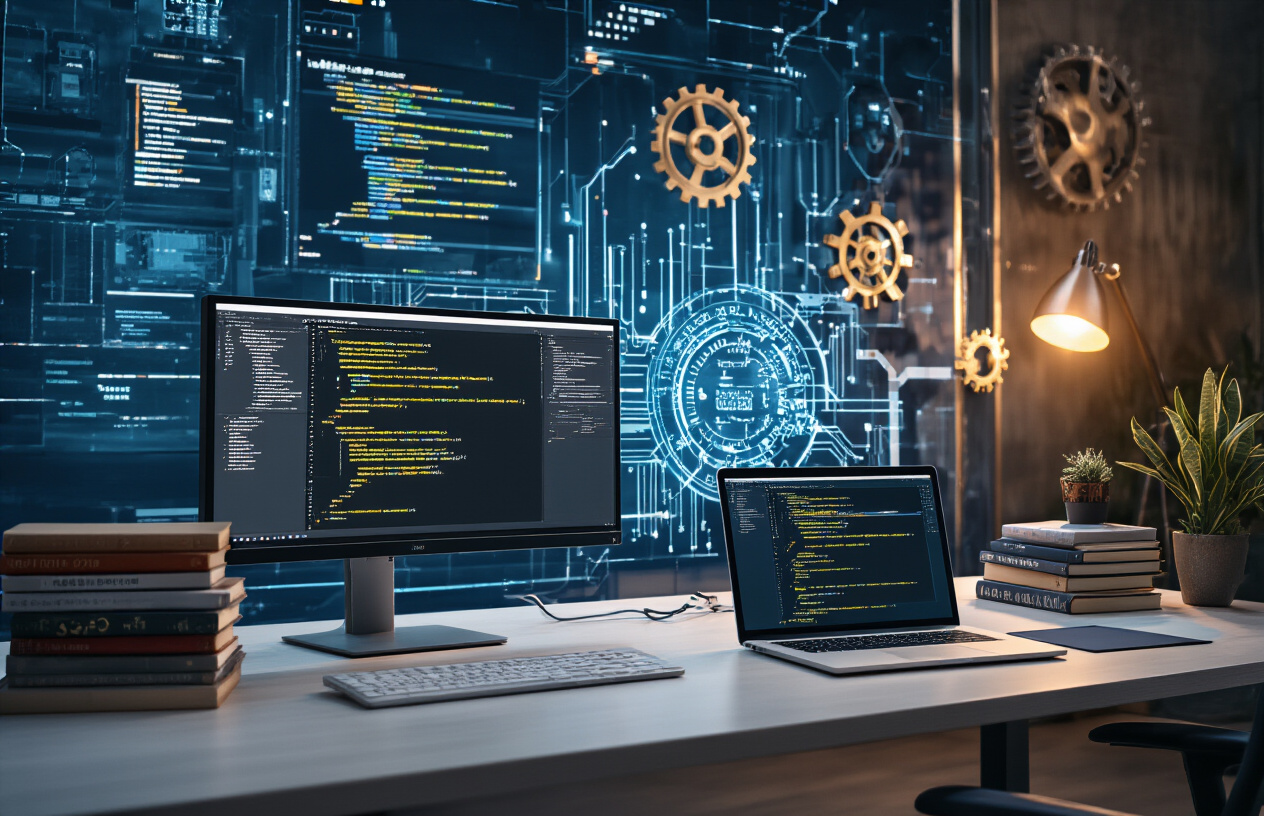
Creating efficient workflows that leverage both approaches
Modern development teams achieve peak productivity by weaving AI-powered development tools with traditional programming tools into seamless workflows. Start your coding sessions with AI coding assistants like GitHub Copilot or Cursor for rapid prototyping and boilerplate generation, then switch to your favorite IDE for complex debugging and architecture decisions. Set up automated pipelines where AI handles repetitive tasks like code reviews and documentation while traditional tools manage critical deployment processes. The key lies in defining clear handoff points – use AI for initial code generation, traditional tools for refinement, and hybrid approaches for testing. This strategic combination reduces development time by 40% while maintaining code quality standards that enterprise applications demand.
Cost-benefit analysis of maintaining traditional tool licenses
Smart teams evaluate their tool investments based on actual usage patterns rather than industry trends. Traditional software development licenses often cost $200-500 per developer annually, but they provide stability and advanced debugging capabilities that AI development tools currently lack. Calculate your team’s productivity gains from AI tools against the reliability of established IDEs and frameworks. Many successful teams adopt a tiered approach: maintain core licenses for senior developers who handle complex architecture while newer team members leverage AI-powered development platforms for routine tasks. The sweet spot typically involves keeping 60% traditional tool licenses and supplementing with AI subscriptions, creating a balanced ecosystem that supports both innovation and dependability.
Team training considerations for balanced skill development
Building a versatile development team means training developers in both traditional programming fundamentals and AI-powered development techniques. Start with solid foundations in debugging, system design, and code architecture using traditional tools before introducing AI coding assistants. Developers who master traditional software development first become more effective at directing AI tools and catching their limitations. Create learning paths that alternate between hands-on coding with established IDEs and experimenting with AI development tools on side projects. Schedule monthly workshops where team members share discoveries about new AI features while senior developers demonstrate advanced debugging techniques. This balanced approach ensures your team can adapt to any development scenario without becoming overly dependent on either approach.
Future-proofing development processes for emerging technologies
Prepare your development workflows for rapid technological shifts by building modular processes that accommodate both traditional and AI-powered approaches. Design your CI/CD pipelines with flexibility in mind – use containerized environments that can easily integrate new AI development tools without disrupting existing traditional software workflows. Invest in team members who understand fundamental programming concepts rather than those who only know specific tools. Create documentation standards that work equally well for AI-generated code and human-written code, ensuring long-term maintainability. The most resilient teams treat AI as a powerful assistant rather than a replacement, maintaining strong traditional development skills while staying curious about emerging AI capabilities that could enhance their hybrid development approach.
Making the Right Choice for Your Development Team
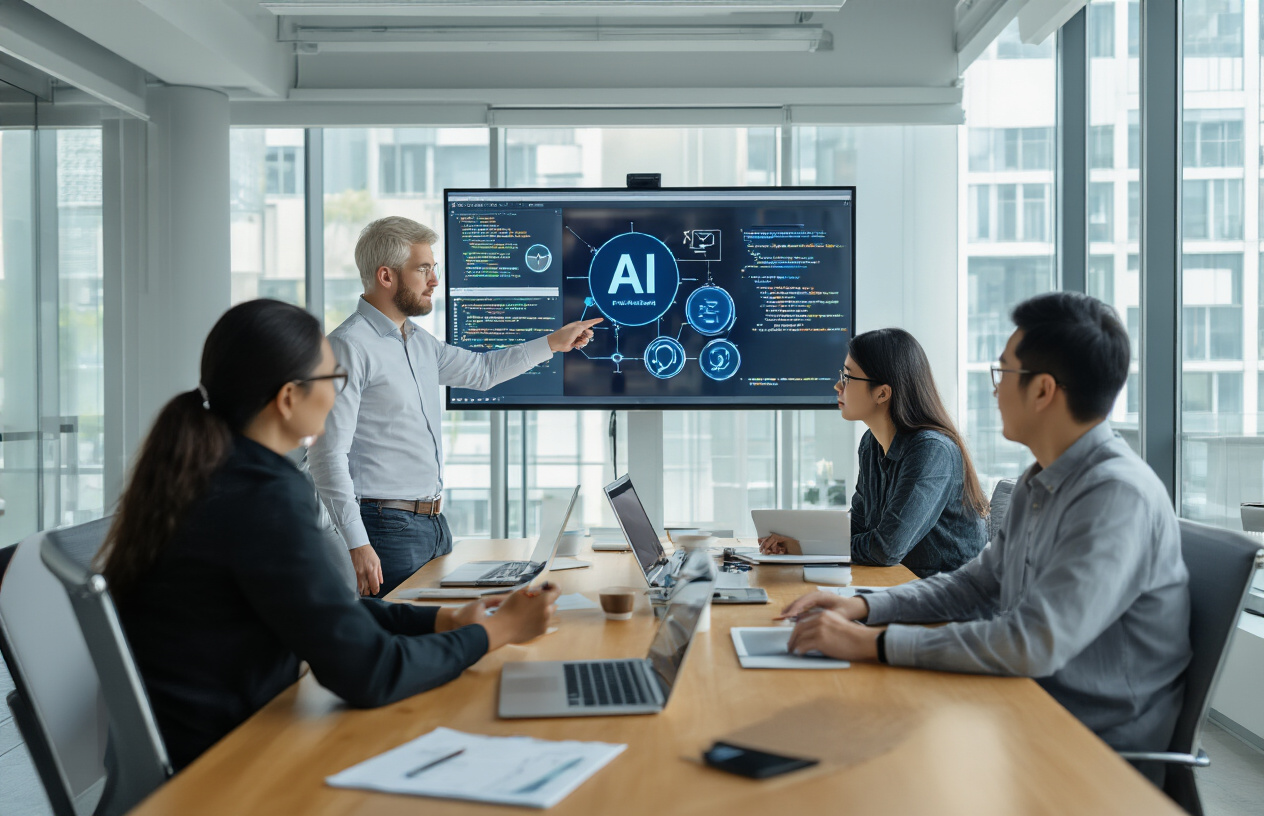
Assessing your project complexity and requirements
Complex enterprise applications with strict security requirements typically need traditional software development tools alongside AI-powered development assistants. Simple web applications or prototypes can leverage AI development tools more heavily, while mission-critical systems demand proven traditional programming tools. Evaluate your project’s scalability needs, integration requirements, and maintenance complexity to determine the optimal balance between AI vs traditional development approaches.
Budget considerations for tool selection and maintenance
AI development tools often require subscription fees and cloud computing costs that can exceed traditional software development tool expenses. Consider licensing costs for development workflows AI platforms, training expenses for your team, and ongoing maintenance requirements. Traditional tools may have higher upfront costs but lower recurring expenses, while AI-powered development solutions offer faster delivery but ongoing operational costs that impact your long-term budget planning.
Timeline factors that influence technology adoption decisions
Tight project deadlines favor AI coding assistants for rapid prototyping and code generation, while long-term projects benefit from traditional development methods that ensure maintainable code quality. Teams familiar with software development tools 2024 can implement hybrid development approach strategies more quickly than those requiring extensive retraining. Consider your team’s learning curve, project milestones, and delivery expectations when choosing between established traditional programming tools and emerging AI development technologies.

AI has transformed how we write code and manage projects, but it hasn’t made traditional development tools obsolete. Smart developers are finding ways to blend AI capabilities with proven methodologies, using automation for repetitive tasks while relying on established frameworks for complex architecture decisions. The best results come from teams that understand when to leverage AI’s speed and when to trust time-tested approaches.
The future belongs to developers who can strategically combine both worlds. Start by identifying which parts of your workflow would benefit most from AI assistance, then gradually integrate these tools while maintaining your core development practices. Your team’s success won’t come from choosing sides between traditional and AI-powered methods – it’ll come from knowing how to use each one at the right time.










